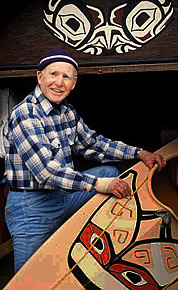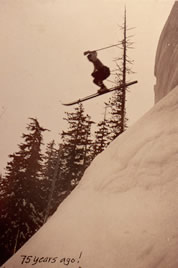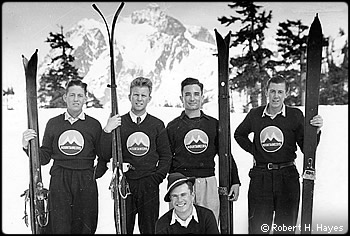 |
 olf Bauer has been a pioneer all his life, a man of many firsts. The scope of his influence has been so broad and has spanned so many years that few even begin to grasp it. Hundreds or even thousands of mountaineers have pioneered new routes in the Northwest, giving our sport its rich history. But the number of people who have pioneered new movements is far smaller. To introduce a new technical foundation, a new approach to safety, or an entirely new branch of mountain sports is an opportunity given to very few. To have done this several times in a lifetime is truly extraordinary. Yet Wolf Bauer has done exactly that. olf Bauer has been a pioneer all his life, a man of many firsts. The scope of his influence has been so broad and has spanned so many years that few even begin to grasp it. Hundreds or even thousands of mountaineers have pioneered new routes in the Northwest, giving our sport its rich history. But the number of people who have pioneered new movements is far smaller. To introduce a new technical foundation, a new approach to safety, or an entirely new branch of mountain sports is an opportunity given to very few. To have done this several times in a lifetime is truly extraordinary. Yet Wolf Bauer has done exactly that.
 |
 |
|
Wolf Bauer with kayak. © Cliff Leight. |
|
 |
Skier, climber, rescuer, kayaker and conservationist, Wolf Bauer has excelled in all of these fields. But what truly sets him apart are his efforts behind the scenes, working quietly and persistently over a lifetime to enable others to excel—and to do so safely. Wolf Bauer’s influence on outdoor recreation in the Northwest is unparalleled. And he’s been at it since 1925.
Wolf’s mother’s family, the Epplers, were Seattle pioneers. His mother attended school in England and spent summers in the Alps, where she met his father. Wolf was born in Bavaria in 1912 and immigrated to Seattle with his family in 1925. Unable to speak English fluently, he was put in the first grade. Each month, as his English improved, he was promoted a grade. By the end of the year, he found himself back in junior high. As Malcolm Bates wrote in Cascade Voices, “It was perhaps the only time in Bauer’s illustrious life that he had to catch up. More often than not Wolf Bauer has been the leader.”
Skiing
Wolf began skiing in 1919 as a schoolboy in the Bavarian Alps. His wooden skis were heavy and long. The bindings were flat toe irons passed through slots cut sideways through the skis, then bent up to fit his hiking boots and threaded with leather straps. In 1921, the film A Fox Hunt (on Skis) through the Engadine inspired Wolf and thousands of Europeans to learn the new alpine skiing techniques of their hero, Hannes Schneider. Wolf witnessed the ski boom in Europe in the early 1920s, and after he arrived in America, he saw it echo in this country a decade later.
In Seattle, Wolf joined the Boy Scouts and was invited by his scoutmaster, Harry Higman, to accompany him on a ski outing to Stampede Pass. Trying to load a streetcar for King Street station, Wolf got his first clue that skiing was not yet a household word in the Northwest. “Poking my evil-smelling slats through the streetcar door at the conductor,” he later recalled, “I was bluntly informed that the System was not in the lumber-hauling business, and that whatever it was that I was carrying did not come under ‘personal and reasonable luggage.’” Fortunately, an old Swede came to his aid, and the two of them managed to convince the conductor that the skis were, in fact, sporting equipment.
 |
 |
|
Wolf Bauer and the shortcut that won the 1933 Mountaineers downhill ski race. Courtesy Wolf Bauer. |
|
 |
In autumn 1929, Wolf was one of three Scouts selected annually to receive a free membership in The Mountaineers. With a few exceptions, the club’s skiers were mostly novices. Wolf brought to The Mountaineers both skiing know-how and competitive fire. In March 1930, he won what was perhaps the first slalom race west of the Mississippi at the club’s Meany Ski Hut, using linked telemarks. That same day he placed third in the state’s first downhill race. The Mountaineer downhillers started en masse and could choose their own routes. Three years later, Wolf won the race by taking a short cut—right into space—over the cornice at the top of Meany Hill.
In 1930, the club held its first Patrol Race, an eighteen-mile dash on skis between the Mountaineer lodges at Snoqualmie Pass and Stampede Pass. This was a team event, with three skiers per team, each required to carry a ten-pound pack of survival gear and finish within a minute of each other. Wolf was too young to race that year and broke trail instead. In 1936, with Chet Higman and Bill Miller, his team beat the previous course record by nearly an hour, skiing those eighteen miles in 4 hours, 37 minutes, 23 seconds. Their time has never been beaten.
In 1934, the Seattle Post-Intelligencer and Washington Ski Club organized the wildest ski race ever held in North America, the Silver Skis, from Camp Muir to Paradise on Mount Rainier. The first Silver Skis was staged like a thoroughbred horse race, with sixty racers lined up side-by-side at Camp Muir and started simultaneously. Wolf had trained for weeks doing deep knee bends to enable him to hold a crouch position against the expected headwinds. He later recalled, “While this paid off in the later stages, the extra speed cost me both poles, goggles, and a broken ski still hanging precariously together with a steel-edge fastening—result of a summersault at nearly sixty miles per hour. I was leading at the time, but my spot of reckoning became the waterloo for many behind me, in some instances with serious consequences.” Somewhat dazed, Wolf picked himself up and, without poles or goggles, got under way again. Below Panorama Point, he overtook Hans-Otto Giese, a former cross-country champion, to place fifth. Don Fraser, later a member of the U.S. Olympic team, won the race in 10 minutes, 49.6 seconds.
Wolf has continued to ski (and win races) throughout his life. In a 1992 interview with Morris Moen, at the age of 80, Wolf said that thanks to modern equipment, he was skiing better than when he tried out for the U.S. Olympic Team in 1935.
|
 |
| chronology |
| |
 |
| Early Years |
 |
1912
•
(February) Born in Bavaria, Germany.
1919
•
Started skiing in Bavarian Alps.
1925
Family immigrated to Seattle, Washington.
1929
•
Selected for Boy Scout membership in The Mountaineers.
|
 |
| Prolific 1930s |
 |
1930
• First place, Mountaineers first slalom race. (Other slalom and/or downhill victories in 1932, 1933 and 1936.)
• Trailbreaker for Mountaineers first Patrol Race (too young to compete).
1932
• First ascent, McClellans Butte, North Couloir (May 8, with Bob Higman).
1933
• Provided mountaineering instruction to Seattle Explorer Scouts (later to become the Ptarmigan Climbing Club).
1934
• Fifth place, first Silver Skis Race (geschmozzle start).
1935
•
Developed and taught first Mountaineers basic climbing course.
• First ascent, Ptarmigan Ridge, Mount Rainier.
1936
•
First place (team), Mountaineers Patrol Race, new course record.
• Developed and taught first Mountaineers intermediate climbing course.
• First ascent, Mount Goode, North Cascades.
1938
• First ascent (incomplete), Big Four Mountain, North Face (July 7, with John E. Lucas, stopped 250 feet below summit due to late hour and deteriorating weather). |
| |
|
 |



